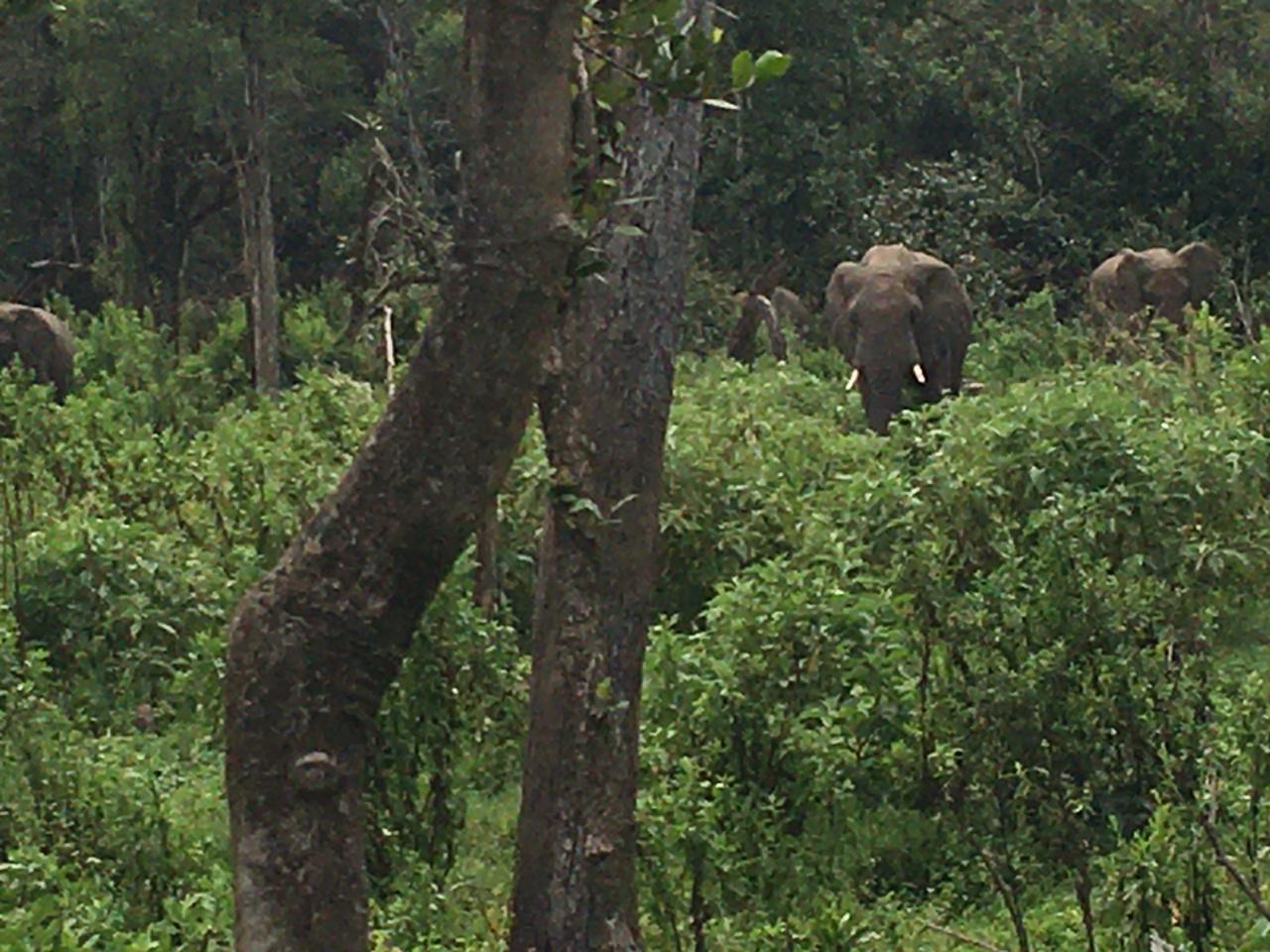As we enter into Mara Elephant Project’s 10th year of operation, we are equipped to handle the increase in habitat destruction activities and bushmeat poaching we’re seeing in the Greater Mara Ecosystem, and January was no exception.

Flooding was prevalent around the Mara in January.
 MEP’s intelligence unit started 2021 off with two ivory busts. Starting on January 5, MEP’s intelligence unit alongside Kenya Wildlife Service (KWS) arrested two suspects in possession of 30 kg of ivory. The team suspects this ivory came from Tanzania and are glad they were able to successfully remove it from the market. Then, on January 14, the MEP intelligence unit along with KWS arrested one suspect in possession of two elephant tusk weighing 11 kilograms estimated to be worth a street value of Ksh.1.1 million according to Citizen TV in Kenya. The suspect was arrested on the Kehancha-Ntimaru road near the border of Tanzania and Kenya. The national news in Kenya featured ivory seizures and arrests that involved MEP intelligence on January 5 and again on January 14, both on Citizens TV.
MEP’s intelligence unit started 2021 off with two ivory busts. Starting on January 5, MEP’s intelligence unit alongside Kenya Wildlife Service (KWS) arrested two suspects in possession of 30 kg of ivory. The team suspects this ivory came from Tanzania and are glad they were able to successfully remove it from the market. Then, on January 14, the MEP intelligence unit along with KWS arrested one suspect in possession of two elephant tusk weighing 11 kilograms estimated to be worth a street value of Ksh.1.1 million according to Citizen TV in Kenya. The suspect was arrested on the Kehancha-Ntimaru road near the border of Tanzania and Kenya. The national news in Kenya featured ivory seizures and arrests that involved MEP intelligence on January 5 and again on January 14, both on Citizens TV.
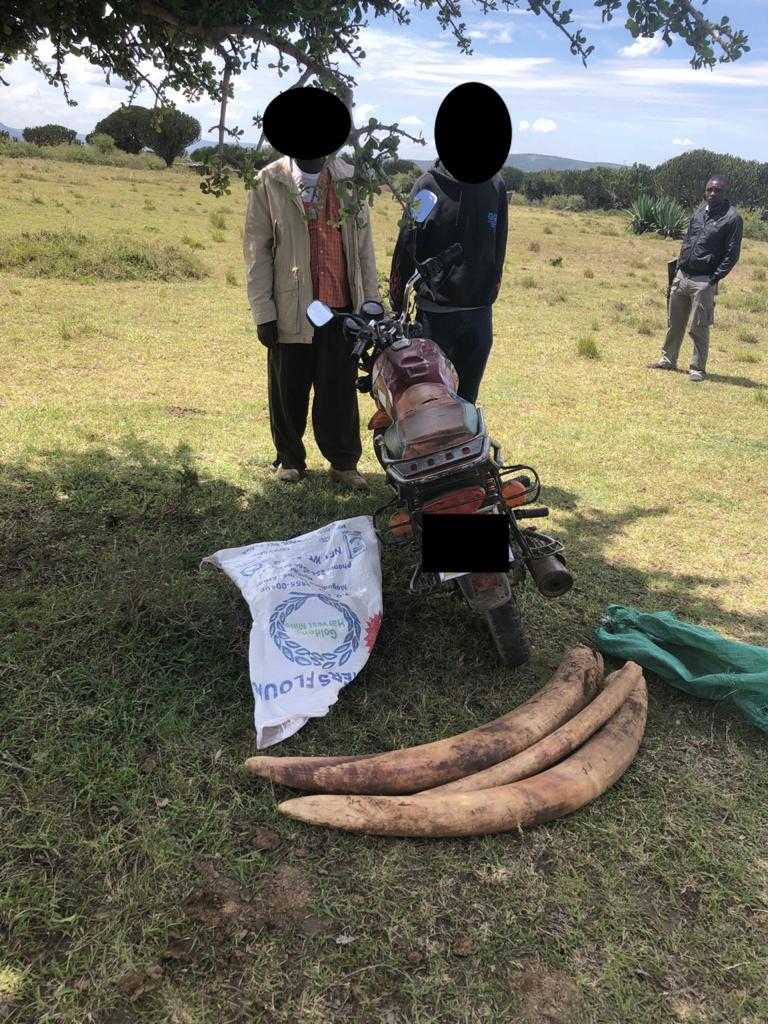
The two ivory busts led by the MEP intelligence unit in January resulting in a total of 41 kg of ivory seized and three suspects arrested.
In terms of bushmeat poaching, MEP rangers alongside government partners arrested two bushmeat poaching suspects, confiscated 15 kg of bushmeat and removed 19 snares.

The SWT Mau De-Snaring Unit rangers on January 14 during their normal patrol arrested two suspects with 15 kg of bushmeat and 4 snares. They also burnt down a poachers’ hut.
In total, in January, MEP rangers alongside government partners also arrested 22 habitat destruction suspects, recovered two power saws, destroyed 31 kilns and 30 sacks of charcoal and confiscated 370 posts and 105 pieces of timber.
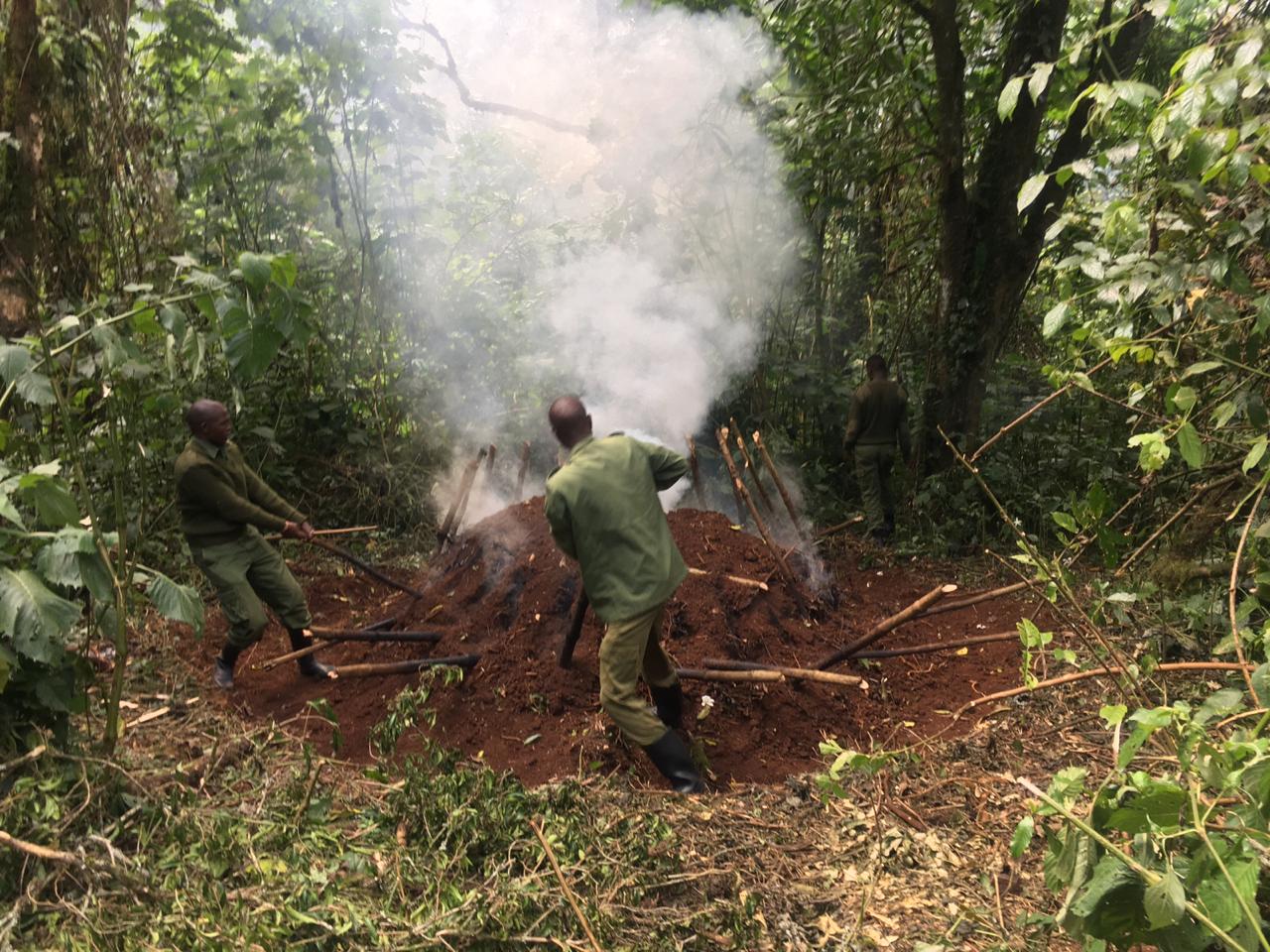 Above: A kiln destroyed in the Mau Forest in January. Below: A charcoal arrest on January 4 with 18 bags of charcoal on donkeys.
Above: A kiln destroyed in the Mau Forest in January. Below: A charcoal arrest on January 4 with 18 bags of charcoal on donkeys.

As crops ripen across the Mara River near MEP’s HQ, we have deployed a team to near the Naronyo Hill on Olchoro Conservancy so that they are in close proximity of the crop raiding elephants who cross into crops at night. The rangers patrol in their vehicle along the river and are tasked with stopping the herds at the crossing points with their mitigation toolkit. In total, MEP rangers responded to five conflict incidents in January.
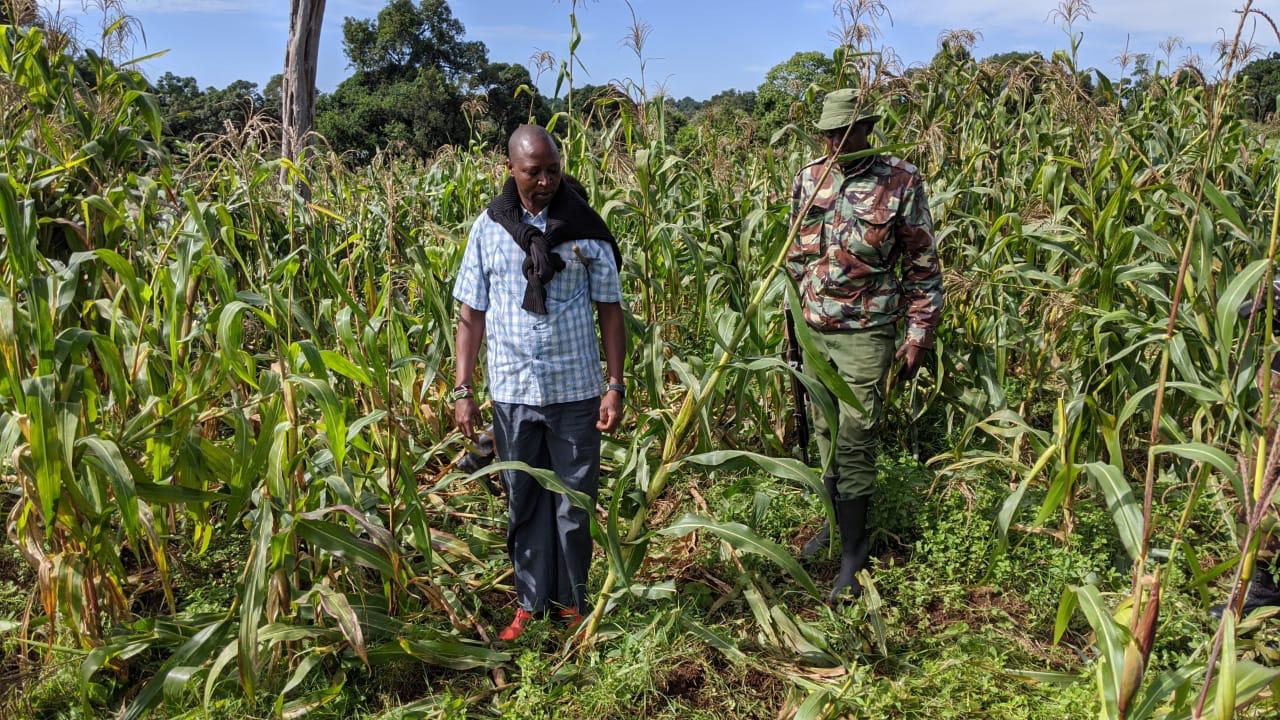
A group of five elephants raided a crop farm at night in Kilaye area on January 4.
Collared elephant Chelsea was spotted the first week of January by the Olkinyei Conservancy rangers with a wound on her side, a very dangerous place that needed immediate veterinary intervention. Chelsea was originally collared by KWS and MEP in May 2015 and in June 2020, her collar ran out of its battery life and MEP rangers were tasked with keeping track of her while on patrol until she could be fitted with a new collar. Replacing this collar became more urgent when they discovered her wound. So, on January 8, MEP the MEP leased helicopter was deployed to complete this mission. Chelsea was successfully darted and treated by KWS Vet Dr. Rono from the KWS HQ in Nairobi for a wound on her side that was obtained from a spear. While being treated, she was also fitted with a new collar that will be monitored 24/7 by KWS and MEP. Chelsea will be closely monitored while she is recovering from her wound, but the prognosis is good.
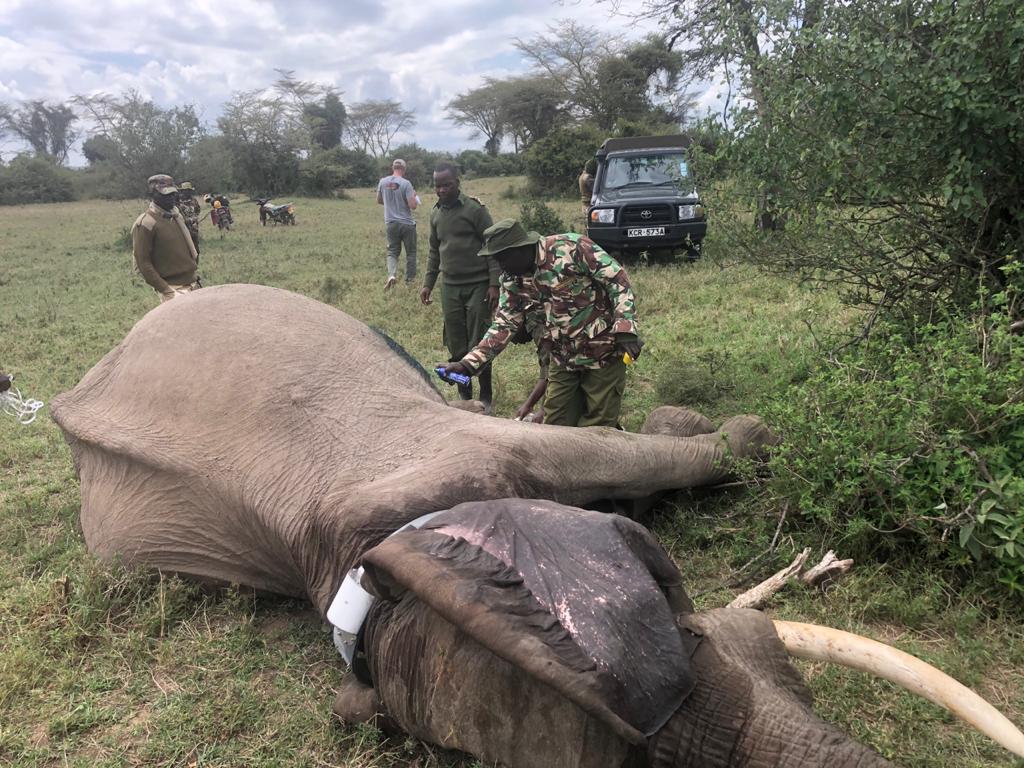
Collared elephant Chelsea receiving treatment and a new collar on January 8.
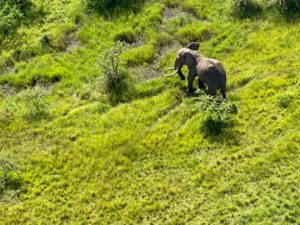 MEP also took the last week of January to aerially monitor Fred, Ivy, Fitz, David, Kegol (pictured left), Kiambi, Lempiris, Chelsea, Matali, Hannibal, Napoleon and two herds in Olarro Conservancy and the Southern Loita area. Kiambi was spotted with a bachelor herd and Chelsea was with her usual family herd; both doing well. The Southern Loita area is a spot where KWS and MEP are looking for good elephant candidates to collar in 2021 to establish movement patterns around the Sand River. Aerial monitoring of KWS and MEP’s collared elephants is a key component to keeping them safe. A view from the air allows us to monitor the elephant’s well-being and the collar’s overall wear-and-tear. Beyond just the collared elephant, while up in the air, we check the whole herd for injuries and we take notes on the elephant’s herd size, noting new babies as well as any changes in the land cover like new settlements, fences or roads. We also monitor our forested areas for habitat destruction and relay these coordinates to our ground teams. All of this is combined in MEP’s own instance of EarthRanger to create a broader picture of how elephants are using the landscape based on factors like fences and settlements.
MEP also took the last week of January to aerially monitor Fred, Ivy, Fitz, David, Kegol (pictured left), Kiambi, Lempiris, Chelsea, Matali, Hannibal, Napoleon and two herds in Olarro Conservancy and the Southern Loita area. Kiambi was spotted with a bachelor herd and Chelsea was with her usual family herd; both doing well. The Southern Loita area is a spot where KWS and MEP are looking for good elephant candidates to collar in 2021 to establish movement patterns around the Sand River. Aerial monitoring of KWS and MEP’s collared elephants is a key component to keeping them safe. A view from the air allows us to monitor the elephant’s well-being and the collar’s overall wear-and-tear. Beyond just the collared elephant, while up in the air, we check the whole herd for injuries and we take notes on the elephant’s herd size, noting new babies as well as any changes in the land cover like new settlements, fences or roads. We also monitor our forested areas for habitat destruction and relay these coordinates to our ground teams. All of this is combined in MEP’s own instance of EarthRanger to create a broader picture of how elephants are using the landscape based on factors like fences and settlements.

Collared elephant Kiambi and his herd photographed from the air.
Fitz was in the Nyakweri Forest for the most of January. He made several attempts to move east towards the farms thereby breaking geo-fences but MEP’s Alpha team on ground were able to push him back into the forest. He was seen in the company of five other elephants around Kilaye before being pushed back into the forest. MEP had to deploy the helicopter to move Fitz and his herd back into Dupoto Forest from the western edge of the forest which is experiencing a huge amount of destruction. Ritan was displaying similar behavior as Fitz and spent most of January in the Chemesusu Forest (Mau area) and its immediate neighborhood. During the day he foraged deep into the forest and at twilight approached the southern edges of the forest. Sporadically, he staged fast crop-raids into the neighboring farms at night and went back into the forest before sunrise. His farm-raids were picked by our geo-fence analyzer reports in EarthRanger. Hannibal and Napoleon were in the southern slopes of Mt. Suswa at the start of January. They both left the Suswa area and moved about 50 km farther south into Mosiro, where they spent time in unprotected areas. In the second week of January, both bulls left Mosiro at dusk and moved south-west into the riverine thicket of Ewuaso Ngiro to crop raid under the cover of darkness. They broke a geo-fence and whizzed through dense farms in Ewuaso Ngiro South. The crop-raid seemed well strategized starting at around sunset entering the farms at midnight and heading back at the crack of dawn.
Collared elephant Fitz photographed by MEP rangers in the Nyakweri Forest in January.
This month MEP’s Research Department welcomed David Kimanzi. David is a GIS specialist and will be working with Wilson Sairowua and Dr. Jake Wall closely to collect new spatial layers, manage MEP’s EarthRanger platform, monitor all collared elephants, and produce cartographic and analytical outputs from our growing conservation datasets. MEP’s three field assistants mapping fences, roads and landcover ground-truthing points recorded 233 km of fences and 245 LCC points in January.
In January, there were amazing first entries in the 2021 Greatest Maasai Mara photo competition. Thank you to Guillaume Niger, Oliver Zeid, Vikram Ghanekar, Yarin Klein, Roisin Allen, Andrew Liu, Thorsten Hanewald, Julie Lovens, Ivan Glaser, William Fortescue, Eric Janus, Edouard Wenseleers, Sushil Chauhan, Adam Zdebel, Sean McDermott, Charlotte Rhodes, Karin Bishop, Rizwan Jiwa, Clair Nicol and Manoj Shah for designating MEP as your beneficiary.

A January entry in the GMM competition by Roisin Allen.
